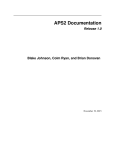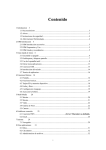Download InFocus IN5100 User's Manual
Transcript
IN5100 Series Networking Guide This guide is only intended to explain Network Functions. For safety, operations or any other issues, refer to the projector’s User’s Guide or Safety Booklet. TABLE OF CONTENTS Network Functions Before using the network functions Configuring and controlling the projector via a web browswer Settings Network Information Network Setting Mail Settings Alert Settings Schedule Settings Date/Time Settings Security Settings Projector Control Projector Status Network Restart Failure and Warning Alerts via E-mail Mail Settings Projector management via SNMP Controlling the projector via scheduling Date/Time Settings Schedule settings 1 2 2 3 5 6 7 8 9 10 11 12 13 14 15 15 15 17 18 18 18 Network Functions This projector is equipped with the following network functions. Configuring and Controlling the Projector via a Web Browser You can change the settings of or control the projector via a network by using a web browser from a PC that is connected to the same network. Failure & Warning Alerts via E-mail The projector can automatically send an alert to specified e-mail addresses when the projector requires maintenance or has encountered an error. Projector Management via SNMP This projector is SNMP (Simple Network Management Protocol) compliant, allowing you to monitor it from a remote location using SNMP software. Controlling the Projector via Scheduling You can schedule the projector to perform various functions according to the DATE and TIME. Before using the network functions To use the network functions of this projector, the projector must be configured to suit your network. Consult with your network administrator before connecting the projector to your network. Incorrect network configuration of this projector may cause problems on your network. Connect to the Gateway (The router/PC that forwards traffic to a destination outside of the subnet of the transmitting device) from the network terminal on the projector using a CAT-5 cable and configure the following settings. If using a network with DHCP enabled: The projector’s network settings can be configured automatically when [DHCP] on the network menu is set to On (the checkbox is checked). Please refer to DHCP in the User’s Guide Network menu. If a fixed / static IP address is required, please configure your projector according to the steps in the following section. If using a network system that does not have DHCP enabled or if using a fixed IP address on a network system equipped with DHCP enabled: Configure the following settings on the network menu. 1 [DHCP]: Disable DHCP (Set [DHCP] to Off (the checkbox is unchecked). 2 [IP ADDRESS]: Enter an appropriate IP address for the projector to connect to your network. 3 [SUBNET MASK]: Enter an appropriate SUBNETMASK for the projector to connect to your network. 4 [DEFAULT GATEWAY]: Enter an appropriate Gateway (the router/PC that forwards traffic to a destination outside of the subnet of the transmitting device) address for the projector to connect to your network. 2 Configuring and controlling the projector via a web browser You can adjust or control the projector via a network from a web browser on a PC that is connected to the same network. NOTE: • Internet Explorer 5.5 or higher or Netscape 6.2 or higher are required. • If JavaScript is disabled in your web browser configuration, you must enable JavaScript in order to use the projector web pages properly. See the Help files for your web browser for details on how to enable JavaScript. • If no operations are performed via a web browser for approx. 50 seconds the system will automatically log off. Please Re-log on to continue operations via a web browser. • After you logon, a small, blank window will appear behind the main operation window. Please do not close this small, blank window. If this window is closed, the system will automatically log off after certain period of time even if an operation is being performed. The small, blank window will close when the main operation window is closed. • The small, blank window may be considered a pop-up and be blocked if your browser or other security software is set to block pop-ups. If the window is blocked, you need to choose the option to allow pop-ups to be shown. • It is recommended that all web browser updates be installed. It is especially recommended that all users running Internet Explorer on a Microsoft Windows version prior to Windows XP Service Pack 2 install security update Q832894 (MS04-004) or the web browser interface may not be displayed correctly. And when using an older version of Internet Explorer, during operations the browser will log out after 50 seconds. When configuring or controlling the projector via a web browser, an ID and password are required. There are two types of IDs, Administrator IDs and User IDs. The following chart describes the differences between user and administrator IDs. Item Description Administrator ID User ID Network Info Displays the projector’s current network configuration settings. YES YES Network Settings Displays and configures network settings. YES N/A Mail Settings Displays and configures e-mail addressing settings. YES N/A Alert Settings Displays and configures failure & warning alerts. YES N/A Schedule Settings Displays and configures schedule settings. YES N/A Date/Time Settings Displays and configures the date and time settings. YES N/A Security Settings Displays and configures passwords and other security settings. YES N/A Projector Control Controls the projector. YES YES Projector Status Displays and configures the current projector status. YES YES Network Restart Restarts the projector’s network connection. YES N/A 3 Below are the factory default settings for administrator IDs, user IDs and passwords. Item ID Password Administrator ID Administrator <blank> User ID User <blank> 4 Settings Refer to the following for configuring or controlling the projector via a web browser. Example: If the IP address of the projector is set to 192.168.1.10: 1 Enter [http://192.168.1.10] into the address bar of the web browser and the screen below will be displayed. 2 Enter your ID and password and click [Logon]. If the logon is successful this screen will be displayed (if logged on as an Admin). 3 Click the desired operation or configuration item on the main menu located on the left-hand side of the screen. 5 Network Information NOTE: All screen images shown in this document are screens of a logon using an Administrator’s ID. Any Administrator-only functions will not be displayed when using a User ID. Displays the projector’s current network configuration. Item Description DHCP Displays the DHCP configuration settings. IP Address Displays the current IP address. Subnet Mask Displays the Subnet Mask. Default Gateway Displays the Default Gateway. MAC Address Displays the MAC Address. Firmware Date Displays the network firmware time stamp (Admin ID only). Firmwave Version Displays the network firmware version number (Admin ID only). 6 Network Setting Displays and configures network settings. Item Description IP Configuration DHCP On/ Off IP Address Subnet Mask Default Gateway Configures network settings. Enables/disables DHCP. Configures the IP address when DHCP is disabled. Configures the Subnet Mask when DHCP is disabled. Configures the Default Gateway when DHCP is disabled. Projector Name Configures the projector name. SysLocation Configures the location to be referred to when using SNMP. SysContact Configures the contact information to be referred to when using SNMP. NOTE: • The new configuration settings are activated after restarting the network connection. When the configuration settings are changed, you must restart the network connection. You can restart the network connection by clicking [Network Restart] on the main menu. • If you connect the projector to an existing network, consult a network administrator before setting server addresses. 7 Mail Settings Item Description Send Mail Click the [Enable] check box to use the e-mail function. Configure the conditions for sending email under [Alert Settings]. SMTP Server IP Address Configures the address of the mail server in IP format. Sender E-mail address Configures the sender e-mail address. The length of the sender e-mail address can be up to 255 alphanumeric characters. Recipient E-mail address Configures the e-mail address of up to five recipients. You can also specify [TO] or [CC] for each address. The length of the recipient e-mail address can be up to 255 alphanumeric characters. Click the [Apply] button to save the settings. NOTE: • You can confirm whether the mail settings work correctly using the [Send Test Mail] button. • If you connect the projector to an existing network, consult a network administrator before setting server addresses. 8 Alert Settings Item Description Lamp won’t strike Lamp won’t turn on after 5 attempts. Lamp Time Over Lamp has exceeded its specified lifetime. Lamp unexpectedly goes out Lamp failed after it had successfully lit. Fan failure Fan is not working. Over temp condition Projector is overheating. Unidentifiable Error Unknown error. Lamp Cover Error The lamp door is not installed properly. Filter Time Over Filter should be cleaned. Temp Sensor Out Sensor is not working. Schedule Execution Error A scheduled event did not take place. Overheating alarm Projector is overheated. Lamp time custom alarm Allows you to specify when (after how many hours) the lamp alarm message should be sent. Filter time custom alarm Allows you to specify when (after how many hours) the filter alarm message should be sent. Clicking each Alert brings up a dialog box where you can specify that an email be sent to alert the appropriate personnel that an error has occurred. Subject can be 255 characters, Text can be 1024 characters. 9 Schedule Settings Item Description Daily Schedule Schedule List Configures the daily schedule. Click the [Enable] check box to enable daily scheduling. Displays the current daily schedule. Sunday-Saturday Schedule Schedule List Configures the Sunday through Saturday daily schedules. Click the [Enable] check box to enable daily scheduling. Displays the current daily schedule. Specific date 1-5 Schedule Month/Day Schedule List Configures the specific date (No.1-5) schedule. Click the [Enable] check box to enable specific date (No.1-5) scheduling. Configures the Month and date. Displays the current specific date (No.1-5) schedule. Click the [Apply] button to save the settings. To add additional functions and events click the [Add] button and set the following items. Item Time Command Power Parameter Source Parameter Description Configures the time to execute commands. Configures the commands to be executed. Configures the parameters for power control. Configures the parameters for input switching. Click the [Register] button to add new commands to the Schedule List. Click the [Delete] button to delete commands from the Schedule list. 10 Date/Time Settings Item Description Current Date Configures the current date in Year/Month/Day format. Current Time Configures the current time in Hour:Minute:Second format. Daylight Savings Time Start-End Month/week/day/hour/minute Click the [ON] check box to enable daylight savings time and set the following items. Configures the date and time daylight savings time begins/ends. Configures the month daylight savings time begins (1~12)/the week of the month (First, 2,3,4,Last)/the day (Sun-Sat)/the hour (0-23)/minute (0-59) Time difference Configures the time difference from GMT (hours:minutes). Set the same time difference as the one set on your PC. If unsure, consult your network administrator. SNTP Click the [ON] check box to retrieve Date and Time information from the SNTP server and set the following items. Configures the SNTP server address in IP format. Consult with your network administrator to get the IP address of your SNTP (time/date) server. Configures the interval at which to retrieve Date and Time information from the SNTP server. (hours:minutes). SNTP Server IP Address Cycle Click the [Apply] button to save the settings. NOTE: The new configuration settings are activated after restarting the network connection. The network connection must be restarted when the configuration settings are changed, The network connection can be restarted using [Network Restart] on the main menu. • If you connect the projector to an existing network, consult a network administrator before setting server addresses. • To enable the SNTP function, the time difference must be set. SNTP servers report time in Greenwich mean time (GMT)/Universal time; the time difference describes how many hours to add/subtract to get your local time. • The projector will retrieve DATE and TIME information from the Timeserver and override time settings when SNTP is enabled. 11 • The Internal Clock’s time may not remain accurate. Using SNTP is recommended to maintain accurate time. Security Settings Item Description Administrator authority Admin ID Admin Password Configures the Administrator ID and Password. Configures the Administrator ID. The length of the text can be up to 32 alphanumeric characters. Configures the Administrator Password. The length of the text can be up to 255 alphanumeric characters. User authority User ID User Password Configures the User ID and Password. Configures the User ID. The length of the text can be up to 32 alphanumeric characters. Configures the User Password. The length of the text can be up to 255 alphanumeric characters. SNMP Community Name Configures the community name if SNMP is used. Configures the community name. The length of the text can be up to 64 alphanumeric characters. Click the [Apply] button to save the settings. NOTE: • The new configuration settings are activated after restarting the network connection. The network connection must be restarted when the configuration settings are changed. The network connection can be restarted using [Network Restart] on the main menu. 12 Projector Control Item Description Main Basic projector commands including power on/off and changing source. Picture Picture settings including keystone, contrast, and brightness. Settings Other settings including audio, source assignment, and system configuration. NOTE: For detail about projector control functions, see the projector’s User’s Guide. 13 Projector Status Item Description Error Displays the current error status Lamp Time Displays the usage time for the current lamp. Total Lamp Hours Displays the usage time for the all lamps Filter Time Displays the usage time for the current filter. Power Status Displays the current power status. Current Source Displays the current input signal source. Blank On/Off Displays the Blank On/Off status. Mute Displays the current Mute On/Off status. Freeze Displays the current Freeze On/Off status. 14 Network Restart Item Description Restart Restarts the projector’s network connection to activate new configuration settings. NOTE: Restarting requires you to re-log on to control or configure the projector. Failure and Warning Alerts via E-mail The projector can automatically send an alert to specified e-mail addresses when the projector requires maintenance or has encountered an error. NOTE: • Up to five e-mail addresses can be specified. • The projector may be not able to send e-mail if the projector suddenly loses power. Mail Settings NOTE: A Network Restart is required after the SMTP Port configuration settings have changed. Click [Network Restart] and configure the following items. 1 Click [Mail Settings] and configure each item. Refer to the [Mail Settings] item in [Configuring and Controlling the Projector via a Web Browser] for further information. 2 Click the [Apply] button to save the settings. NOTE: Click the [Send Test Mail] button in [Mail Settings] to confirm that the e-mail settings are correct. The following mail will be delivered to the specified addresses. 15 Subject line: Test Mail <Projector name> Text: Send Test Mail Date <Testing date> Time <Testing time> IP Address <Projector IP address> MAC Address <Projector MAC address> 3 Configure the Failure/Warning Alerts via E-mail settings. Click [Alert Settings] on the main menu. 4 Select and configure each alert item. Refer to [Alert Settings] in [Configuring and Controlling the Projector via a Web Browser] for further information. 5 Click the [Apply] button to save the settings. Failure/Warning e-mails are formatted as follows: Subject line: <Mail title> <Projector name> Text: <Mail text> Date <Failure/Warning date> Time <Failure/Warning time> IP Address <Projector IP address> MAC Address <Projector MAC address> 16 Projector management via SNMP NOTE: • It is recommended that SNMP functions be carried out by a network administrator. • SNMP management software must be installed on the computer to monitor the projector via SNMP. SNMP Settings Configure the following items via a web browser to use SNMP. Example: If the IP address of the projector is set to 192.168.1.10: 6 Enter [http://192.168.1.10] into the address bar of the web browser. 7 Enter the Administrator ID and Password and click [Logon]. 8 Click [Security Settings] on the main menu. 9 Click [SNMP] and set the Community Name on the screen that is displayed. Click the [Apply] button to save the settings. NOTE: • A Network Restart is required after the Community Name has been changed. • Click [Network Restart] and configure the items. • Make sure SNMP sysLocation and SNMP sysContact in the Network Settings page are defined. 17 Controlling the projector via scheduling The projector can be automatically controlled via scheduling. NOTE: • You can schedule the following control events: Power ON/OFF, Input Source. • There are 3 types of Scheduling, 1) daily 2) day of the week 3) specific date. • The priority for scheduled events is as follows 1) specific date 2) day of the week 3) daily. • Up to five specific dates are available for scheduled events. Priority is given to those with the lower numbers when more than one event has been scheduled for the same date and time (e.g., “Specific day No. 1” has priority over “Specific day No. 2” and so on. • Be sure to set the date and time before enabling scheduled events. Date/Time Settings The Date/Time setting can be adjusted via a web browser. Example: If the IP address of the projector is set to 192.168.1.10: 1 Click [Date/Time Settings] on the main menu and configure each item. Refer to the [Date/Time Settings] item in [Configuring and Controlling the Projector via a Web Browser] for further information. 2 Click the [Apply] button to save the settings. NOTE: • A Network Restart is required after the Daylight Savings Time or SNMP configuration settings have been changed. • The battery for the built in clock may be dead if the clock loses time even when the DATE and TIME have been set correctly. Replace the battery by following the instructions on replacing the battery in the projector’s User’s Guide. • The Internal Clock’s time may not remain accurate. Using SNMP is recommended to maintain accurate time. Schedule settings Schedule settings can be configured from a web browser. Example: If the IP address of the projector is set to 192.168.1.10: 1 Click [Schedule Settings] on the main menu and select the required schedule item. 2 Click the [Enable] check box to enable scheduling. 3 Enter the Date (Month/Day) for specific date scheduling. 4 Click [Add] and set the hour, command and parameters and click [Add This Schedule] when you want to add a command. 5 Click the [Delete] button when you want to delete a schedule. 6 Click the [Apply] button to save the settings. There are three types of scheduling. 1 Daily: Perform the specified operation at a specified time every day. 2 Sunday ~ Saturday: Perform the specified operation at the specified time on a specified day of the week. 3 Specific Date: Perform the specified operation on the specified date and time. NOTE: • When the schedule function is used, the power cord must 18 be connected to the projector and the outlet and the power switch must be turned on, [|]. The schedule function does not work when the power switch is turned off or the breaker in a room is tripped.

























